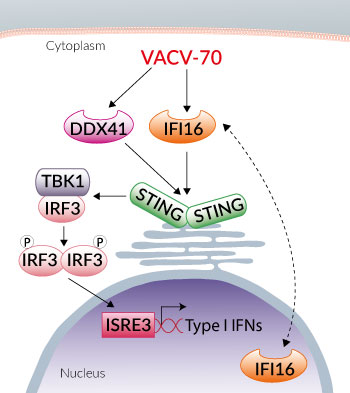VACV-70
| Product | Unit size | Cat. code | Docs. | Qty. | Price | |
|---|---|---|---|---|---|---|
|
VACV-70 Naked CDS Agonist |
Show product |
200 µg |
tlrl-vav70n
|
|

CDS activation with intracellular VACV-70
CDS Agonist
VACV-70 is a 70 bp oligonucleotide containing viral DNA motifs [1]. VACV-70 derives from the vaccinia virus DNA. Transfected VACV-70 potently induces an immune response following recognition by the cytosolic DNA sensors (CDSs), DEAD-box protein 41 (DDX41) [2] or interferon γ-inducible protein 16 (IFI16) [1]. IFI16 induces innate immune responses against single-stranded (ss)and double-stranded (ds) intracellular DNA while DDX41 detects not only viral dsDNA but also bacterial cyclic dinucleotides. DDX41 and IFI16 activation trigger type I interferon (IFN) induction via the STING/TBK1 pathway.
Mode of action:
Intracellular DNA from pathogens is recognized by multiple CDSs, which display contextual preferences for the recognition of DNA [1].
Transfected VACV-70 has been shown to potently induce IFN-β in a Toll-like receptor (TLR)-, DNA-dependent activator of IRFs (DAI)-, and RNA polymerase III (Pol III)-independent, but STING-, TBK1- and IFN regulatory factor 3 (IRF3)-dependent manner [1,2]. Studies have demonstrated that transfected VACV-70 is recognized by DDX41 [2] and IFI16 [1].
To facilitate its intracellular delivery, VACV-70 should be complexed with a cationic lipid transfection agent, such as LyoVec™.
Key features of VACV-70:
- Potent inducer of type I IFNs
- Available complexed with the cationic lipid LyoVec™
- Each lot is functionally validated
InvivoGen also offers VACV-70/ LyoVec™, a formulation of VACV-70 complexed with the cationic lipid transfection reagent LyoVec™, and VACV-70c (control), a single-stranded oligonucleotide which, unlike its double-stranded counterpart does not induce IFNs [1].
![]() Read our review on cytosolic DNA sensors
Read our review on cytosolic DNA sensors
Reference:
1. Unterholzner L. et al., 2010. IFI16 is an innate immune sensor for intracellular DNA. Nat Immunol. 11(11):997-1004.
2. Sharma S. & Fitzgerald KA. 2011. Innate immune sensing of DNA. PLoS Pathog. 7(4):e1001310.
Specifications
Activity: CDS agonist
Formulation: Naked
Sequence:
5’ CCATCAGAAAGAGGTTTAATATTTTTGTGAGACCATCGAAGAGAGAAAGAGATAAAACTTTTTTACGACT 3’
3’ GGTAGTCTTTCTCCAAATTATAAAAACACTCTGGTAGCTTCTCTCTTTCTCTATTTTGAAAAAATGCTGA 5’
Control: VACV-70c single-stranded oligonucleotide
Quality control:
- The biological activity has been verified using cellular assays.
- The absence of bacterial contamination, such as lipoproteins and endotoxins, has been confirmed using HEK-Blue™ TLR2 and HEK-Blue™ TLR4 cells.
Contents
- 200 µg lyophilized VACV-70 Naked
- 1.5 ml endotoxin-free water
![]() Product is shipped at room temperature
Product is shipped at room temperature
![]() Upon receipt, store at -20°C
Upon receipt, store at -20°C
Details
IFI16
IFN γ-inducible protein 16 (IFI16) and its murine orthologue p204 induce innate immune responses against single-stranded (ss) and double-stranded (ds) cytosolic DNA [1,2]. Located predominantly in the nucleus and in small fractions in the cytoplasm, IFI16 can function to activate type I interferon (IFN) responses via STING-mediated phosphorylation of TBK1 and IFN regulatory factor 3 (IRF3) [3]. IFI16 has been reported to sense the DNA of several viruses such as herpesviruses (HSV), cytomegalovirus, and Epstein-Barr virus [1].
DDX41
DEAD-box protein 41 (DDX41) has been shown to induce IFN-β responses upon stimulation with poly(dA:dT), HSV-1, Listeria monocytogenes, and adenovirus [4,5]. This IFN-β induction by DDX41 has been shown to occur via the STING/TBK1/IRF3 signaling pathway. DDX41 was also found to bind to and control the IFN response to cyclic-dinucleotides (CDNs) such as cyclic-di-AMP and cyclic-di-GMP [6].
Reference:
1. Zahid A. et al, 2020. Molecular and Structural Basis of DNA Sensors in Antiviral Innate Immunity. Front Immunol. 2020 Nov 30;11:613039.
2. Unterholzner L. et al., 2010. IFI16 is an innate immune sensor for intracellular DNA. Nat Immunol. 11(11):997-1004.
3. Stratmann S.A. et al., 2015. The innate immune sensor IFI16 recognizes foreign DNA in the nucleus by scanning along the duplex. Elife (2015) 4:e11721.
4. Zhang Z. et al., 2011. The helicase DDX41 senses intracellular DNA mediated by the adaptor STING in dendritic cells. Nat Immunol.12(10):959-65.
5. Stein S.C.& Falck-Pedersen E., 2012. Sensing adenovirus infection: activation of interferon regulatory factor 3 in RAW 264.7 cells. J Virol. 86:4527–4537.
6. Parvatiyar K. et al., 2012. The helicase DDX41 recognizes the bacterial secondary messengers cyclic di-GMP and cyclic di-AMP to activate a type I interferon immune response. Nat Immunol. 13:1155–1161.
Back to the top




